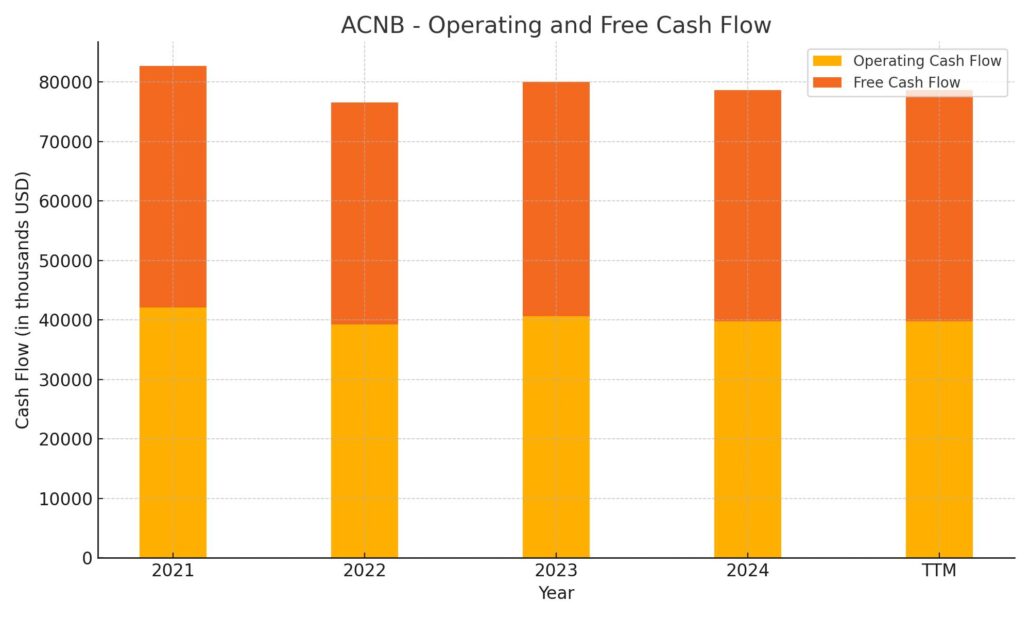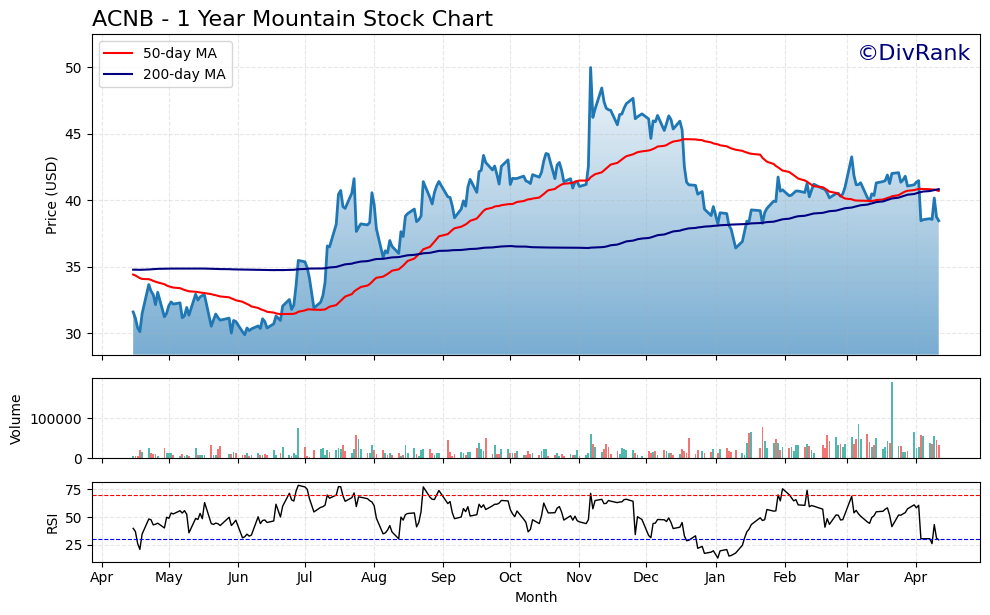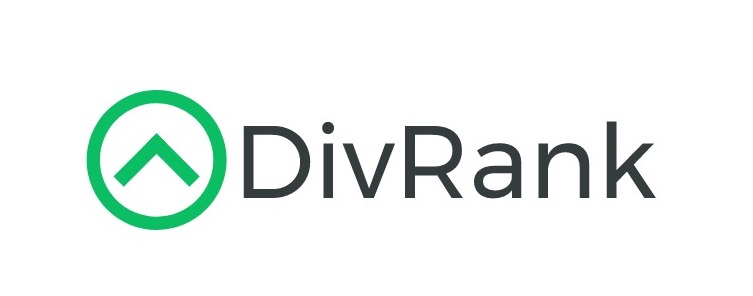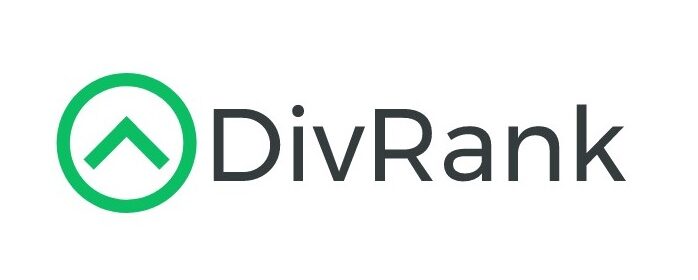Updated 4/14/25
ACNB Corporation (NASDAQ: ACNB) is a regional financial institution serving communities across South Central Pennsylvania and Northern Maryland. Backed by over 160 years of banking experience, the company has built a reputation for steady performance, disciplined capital management, and consistent dividend payouts. With a current market cap of $405 million and a forward dividend yield of 3.33%, ACNB continues to attract income-focused investors looking for reliability and modest growth. Under the leadership of CEO James P. Helt, the bank has maintained strong profitability, a healthy balance sheet, and a low payout ratio near 34%. Earnings per share reached $3.73 in 2024, supported by solid loan growth and stable credit quality. With the upcoming acquisition of Traditions Bancorp and a stock price trading just above book value, ACNB enters the next phase of its strategy focused on expanding its regional footprint while preserving its conservative, performance-driven approach.
Recent Events
Over the last few quarters, ACNB has shown strong upward movement in both fundamentals and market valuation. Just a few months ago, the market cap sat around $319 million. Now, it’s hovering at $405 million. That’s a fairly sharp increase, especially for a regional bank of this size.
Digging into the financials, revenue over the trailing twelve months is at $111 million, and earnings growth has been impressive—net income hit nearly $32 million, up more than 60% from a year earlier. Operating margin? Over 36%. Profit margin? Sitting close to 29%. These are strong efficiency signals for any bank, let alone a relatively small one.
The return on equity is just shy of 11%, and return on assets comes in at 1.32%. Both are signs of steady, competent management that knows how to get the most out of its resources.
Perhaps more importantly for income-focused investors, volume has been stable with slight increases—never a bad thing for liquidity—and the stock’s beta is only 0.68, meaning it doesn’t jump around wildly with the broader market. If you’re after calm, consistent exposure in the financial sector, ACNB fits the bill so far.
Key Dividend Metrics
📈 Dividend Yield: 3.33% forward yield
💵 Annual Dividend: $1.28 per share
📊 Payout Ratio: 33.78%
⏳ 5-Year Average Yield: 3.38%
📆 Most Recent Dividend Date: March 14, 2025
📉 Ex-Dividend Date: February 28, 2025
🧾 Dividend History: Steady with moderate increases
🛡 Dividend Safety: Backed by strong earnings and conservative distribution
Dividend Overview
ACNB offers a forward yield of 3.33%, which stacks up nicely when compared to many bigger-name financial stocks. That yield is based on a quarterly payout of $0.32 per share and an annual total of $1.28. While it might not be the highest-yielding stock on the screen, what you’re getting here is reliability.
The payout ratio sits below 34%, which gives plenty of breathing room. Even if earnings were to hit a speed bump, there’s a significant cushion to maintain the dividend. This is the type of payout policy that suggests management is in no rush to chase yield for the sake of appearance. They’d rather keep it sustainable, which is good news for long-haul investors.
Another thing to like: the five-year average yield lands right around the current one, at 3.38%. That’s a strong sign of consistency. ACNB hasn’t used short-term tactics or fluctuating dividend policies to attract attention. It’s just kept paying, steadily.
It’s also worth noting that there hasn’t been any kind of special dividend or unusual capital action to inflate numbers. This dividend stands on its own—modest, consistent, and fully backed by earnings.
Dividend Growth and Safety
What really stands out with ACNB is how comfortably the dividend sits within its broader financial performance. Earnings per share are $3.73, more than covering the annual dividend with a solid margin. This isn’t a situation where the company is stretching to pay out more than it earns. Quite the opposite—it’s sitting on a solid buffer.
This also shows up in its balance sheet. ACNB holds over $47 million in cash and has about $274 million in debt, but there’s no sense of over-leverage here. The capital structure looks sound, and there’s no indication the bank is taking on unnecessary risk to juice returns. That restraint helps keep the dividend safe.
Return on equity hovering around 11% also tells you something about how well the business is run. For a smaller bank, that’s a very solid number. Return on assets is above 1%, another positive sign that the company knows how to generate income off its base.
A final note—insiders hold about 3.6% of the company, and institutions control roughly 30%. That kind of mix is actually encouraging. There’s skin in the game from management, but not so much that it skews governance. And the institutional presence brings some added scrutiny without overwhelming the boardroom.
For dividend investors, these are all green lights. No gimmicks, no stretch plays—just consistent earnings, a well-covered dividend, and a management team that appears more focused on long-term health than quick wins.
Cash Flow Statement
ACNB Corporation’s cash flow activity over the trailing twelve months reflects a bank operating with a steady hand and disciplined financial management. Operating cash flow came in at $39.78 million, nearly matching the prior year, which signals consistency in the company’s core banking operations. Free cash flow, a key figure for dividend sustainability, was nearly identical at $38.82 million. This highlights strong earnings conversion and solid control over capital expenditures, which remained minimal at under $1 million.

On the investing side, cash flow was modestly positive at $2.43 million, a major contrast from 2022’s deep outflows. It suggests a pause or shift in investment intensity after a major deployment phase. Financing activities, however, pulled back heavily, with a $60.91 million outflow. That included a new $60 million debt issuance, but also smaller equity issuances and a continued trend of modest share repurchases. The result was a significant drop in the ending cash position, now at $47.26 million. While that’s down from previous years, it still reflects a conservative liquidity position. ACNB appears to be operating from a place of stability, using available cash to balance obligations while maintaining strong operating performance.
Analyst Ratings
📊 ACNB Corporation has recently started drawing more attention from analysts, reflecting a noticeable shift in sentiment toward its outlook. 📈 The general consensus stands at a “Moderate Buy,” with an average 12-month price target of $48.50. That points to a potential upside of nearly 26% from where the stock is currently trading around $38.53.
✅ Several analysts have either initiated or upgraded their ratings on ACNB in the past few months. One major firm initiated coverage with an “Outperform” rating and a price target of $47. Another analyst upgrade came with a move from “Hold” to “Buy,” bumping their target price from $37 to $50. What’s driving these positive calls? It’s mostly ACNB’s reliable performance, especially in its earnings growth, high return on equity, and low payout ratio—metrics that point to strong financial health.
💰 The bank’s consistent profitability, with profit margins pushing close to 29% and return on equity hovering around 11%, plays a big role in building that analyst confidence. It’s a name that hasn’t needed dramatic turnarounds or cost-cutting headlines to perform—just steady execution. For investors focusing on stability, yield, and disciplined growth, ACNB is beginning to earn a louder nod from Wall Street.
Earning Report Summary
ACNB Corporation wrapped up 2024 with a performance that was steady and reassuring, especially for investors who appreciate consistency over fireworks. Net income came in at $6.6 million for the fourth quarter, or $0.77 per diluted share. That’s a solid jump from the same time last year—about 61% higher—but it did ease off a bit from the previous quarter. For the full year, ACNB delivered $31.8 million in net income, translating to $3.73 per share, which was just a hair above where it stood in 2023.
Strong Core Metrics
Looking under the hood, return on average assets finished the year at 1.31%, and return on equity clocked in at 10.94%. Those are healthy levels for a regional bank and show the company’s ability to consistently generate value. The net interest margin, though, did take a hit—3.79% for the year compared to 4.07% in 2023. That drop came down to rising funding costs, something a lot of banks have been dealing with lately.
Loan growth was another bright spot. Total loans grew to $1.68 billion, up 3.4% from the prior year, mostly thanks to strength in the commercial real estate segment. Deposits, on the other hand, dipped slightly to $1.79 billion—a drop of around 3.7%.
Credit Quality and Noninterest Activity
Credit quality stayed solid overall. Net charge-offs remained low, just 0.02% of average loans for the year. There was, however, a small bump in non-performing loans, which rose to 0.40% of total loans from 0.26% the year before. That was mainly tied to one healthcare-related commercial loan that moved into non-performing territory, but it doesn’t appear to be part of a broader trend.
On the noninterest income side, the quarter brought in $5.8 million, which was down from Q3—mostly because of seasonal slowdowns in insurance commissions and wealth management fees. But on a full-year basis, ACNB saw noninterest income, excluding securities gains and losses, grow by just over 4%. That was fueled by stronger performance in mortgage and advisory services.
Expense Trends and Capital Strength
Noninterest expenses for the quarter landed at $18.4 million, slightly higher than the third quarter. That increase was mostly tied to equipment and other overhead costs, although those were partially offset by a dip in salaries and benefits. For the year, expenses rose by 7%, with some of that tied to the company’s merger-related activities and higher compensation.
On the capital front, the tangible common equity ratio improved to 10.72%—a nice step up from last year. And the bank’s unrealized losses in its available-for-sale securities portfolio narrowed a bit, easing from $50.2 million down to $47.7 million.
Looking Ahead
CEO James Helt shared his optimism for what’s ahead, particularly pointing to the upcoming acquisition of Traditions Bancorp, which is expected to close early in 2025. He called it a major milestone that will help form one of Pennsylvania’s largest community banks under $5 billion in assets. Helt emphasized the importance of a smooth transition for both employees and customers, while focusing on long-term value creation for shareholders.
Chart Analysis

Price Action and Trend Behavior
ACNB has had a mixed year when you zoom out and look at the broader trend. Starting in the low 30s, the stock moved into a fairly strong uptrend through summer and fall, peaking near $50 in late November. That rally coincided with a bullish crossover, where the 50-day moving average climbed above the 200-day moving average—often seen as a sign of strength. From there, things cooled off. The stock has since rolled over and pulled back steadily into spring, with the price now hovering just under both the 50-day and 200-day moving averages.
What’s particularly notable is that the 50-day MA is now curving down and meeting the 200-day from above. If that crossover completes, it would mark a bearish signal—something traders refer to as a death cross. But it’s not just about the technicals crossing; it’s also the context. Price has already been drifting sideways to lower for a few months, signaling some loss of momentum.
Volume and Participation
Looking at the volume bars, there’s no major sustained spike, but there are occasional bursts—mostly tied to earnings and other news events. The overall pattern suggests interest is steady, though not euphoric. Most of the heavy volume came during moments of quick price movement, which aligns with short-term reactions rather than long-term accumulation.
Momentum and RSI
The RSI at the bottom of the chart tells a story of fading strength. Through much of the second half of 2023, RSI hovered in the upper half of the range, at times nearing overbought territory. That changed in early 2024, with the stock slipping into oversold conditions briefly in January. It recovered a bit into February and March, but now it’s back near the low 30s again. That suggests buyers are hesitant and sellers are slowly taking control.
For those watching long-term health, it’s encouraging that the stock didn’t collapse on its pullback—it’s more of a drift than a crash. Still, momentum indicators like RSI are showing a lack of conviction from the bulls.
Technical Takeaway
Right now, ACNB looks like it’s in a pause or cooling phase after a strong multi-month rally last year. The convergence of the two moving averages and the RSI’s decline hints at more consolidation or even a further pullback unless a catalyst re-ignites upward momentum. That said, the price hasn’t fallen apart, and the broader structure shows a stock that’s resting after a run, not one in free fall.
If the current level around $38 holds and volume begins to pick up on green days, that would be a sign of potential stabilization. Otherwise, further weakness toward the low 30s from last spring can’t be ruled out.
Management Team
ACNB Corporation is led by President and CEO James P. Helt, a seasoned executive who has been part of the company for over 30 years. His leadership has been rooted in consistent execution and a strong commitment to community-focused banking. Helt has steered ACNB through different economic environments by sticking to fundamentals and avoiding unnecessary risks, which aligns with the company’s steady, long-term outlook.
Working alongside Helt is a group of experienced leaders including Executive Vice President and CFO Jason H. Weber, and Chief Strategy Officer Brett D. Fulk. Together, they’ve shaped a strategy built around stable growth, risk management, and responsible capital allocation. The team’s deep local knowledge and strategic alignment are evident in how the company has handled recent challenges while preparing for upcoming expansion moves like the acquisition of Traditions Bancorp. Their combined leadership has played a key role in maintaining investor confidence and operational stability.
Valuation and Stock Performance
As of mid-April 2025, ACNB’s stock is trading around $38.45, giving it a market cap of just over $405 million. At a trailing price-to-earnings ratio of 10.3, the stock still looks attractively valued when compared to broader market averages and even some of its peers. It reflects a company that’s generating solid earnings without excessive investor expectations built in. That creates room for upside, especially if growth remains on track and margin trends stabilize.
Over the last 12 months, the stock has ranged between $30.24 and $50.72. It peaked late last year, following stronger-than-expected earnings, and has since eased back, tracking broader market movements and some interest rate sensitivity common to financials. While it has given up some of those gains, it remains well above the lows from early 2023. The current price puts it just slightly above its book value per share of $35.46, suggesting a fair-to-moderate premium based on fundamentals. With a beta of 0.68, ACNB also offers relatively low volatility, a trait often appealing to long-term investors.
Risks and Considerations
While ACNB operates with a conservative approach, it’s not without risks. One of the most obvious is geographic concentration. The bank serves South Central Pennsylvania and parts of Maryland, so its exposure is more localized than a national lender. That can be a strength in times of regional stability, but it also means any downturn in that area’s economy could have a more direct impact on performance.
The other factor is interest rates. As with most banks, ACNB’s net interest margin—the spread between what it earns on loans and what it pays on deposits—is sensitive to rate changes. A rapidly rising rate environment can drive funding costs higher, which squeezes profitability. And if loan demand softens at the same time, it becomes harder to offset those pressures.
There’s also the changing landscape of competition. Fintech firms and digital banking solutions are shifting customer expectations, and while ACNB has embraced some digital tools, the speed of innovation across the industry could pressure traditional banks to evolve more quickly than they’re used to. Regulatory shifts, always a wildcard in banking, add another layer of complexity and potential cost.
Final Thoughts
ACNB continues to build on a foundation that’s focused more on execution than hype. The leadership team has decades of experience and a clear understanding of their market, which shows up in the bank’s consistent earnings and dividend track record. While not immune to macroeconomic factors or shifts in the competitive space, the bank’s measured approach and strong financial footing make it well-positioned to weather near-term volatility.
With the upcoming completion of the Traditions Bancorp acquisition, ACNB is taking a meaningful step forward in expanding its footprint without losing its identity. The deal brings new customer relationships and market reach, but it also aligns with ACNB’s strategy of steady, manageable growth. The outlook moving forward depends on how well they integrate that business and maintain their margin stability in a still-uncertain rate environment.
For now, the bank stands out as one of the more grounded, consistent names in the regional banking space. Its story isn’t about chasing headlines—it’s about doing the fundamentals right and delivering steady value year after year.

